Marketing Mix Comparison: Haagen-Dazs and Ben & Jerry's Ice Cream
VerifiedAdded on 2023/01/12
|8
|2080
|54
Report
AI Summary
This report provides a comprehensive analysis of the marketing strategies employed by Haagen-Dazs and Ben & Jerry's ice cream brands, focusing on the four elements of the marketing mix: product, price, place, and promotion. The report begins with an executive summary and introduction, outlining the project's objectives and scope. The main body delves into a comparative analysis of the target markets, product offerings, pricing strategies, distribution channels, and promotional activities of both brands. It examines how each brand segments its market, positions its products, and leverages the marketing mix to achieve its goals. The report considers aspects such as product design, packaging, pricing models, distribution channels, and communication strategies. The report concludes with a summary of key findings and recommendations for both brands based on the analysis, drawing on academic literature to support the arguments. The report references various marketing theories and frameworks to provide a robust and insightful comparison of the two brands' approaches to marketing.
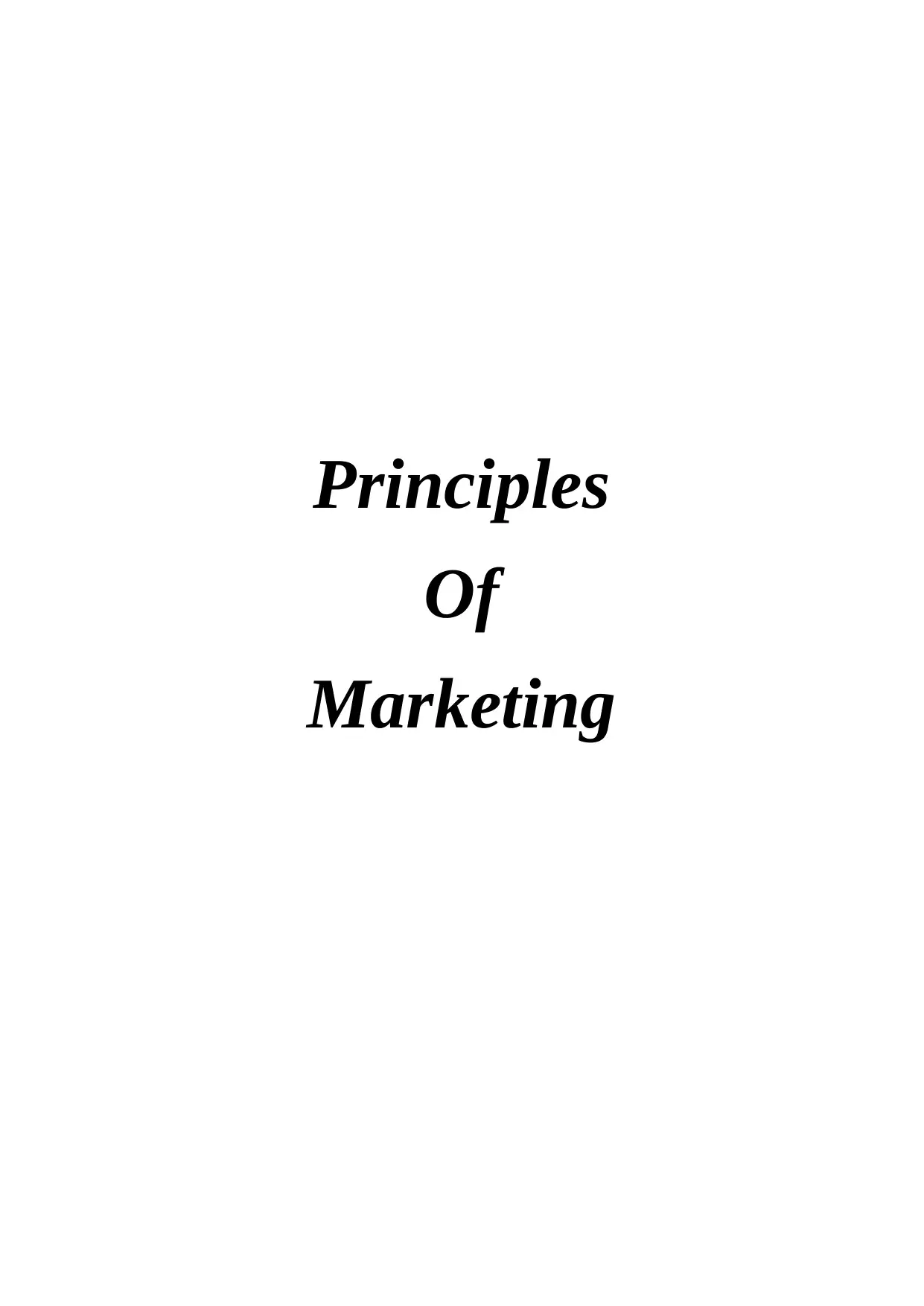
Principles
Of
Marketing
Of
Marketing
Paraphrase This Document
Need a fresh take? Get an instant paraphrase of this document with our AI Paraphraser
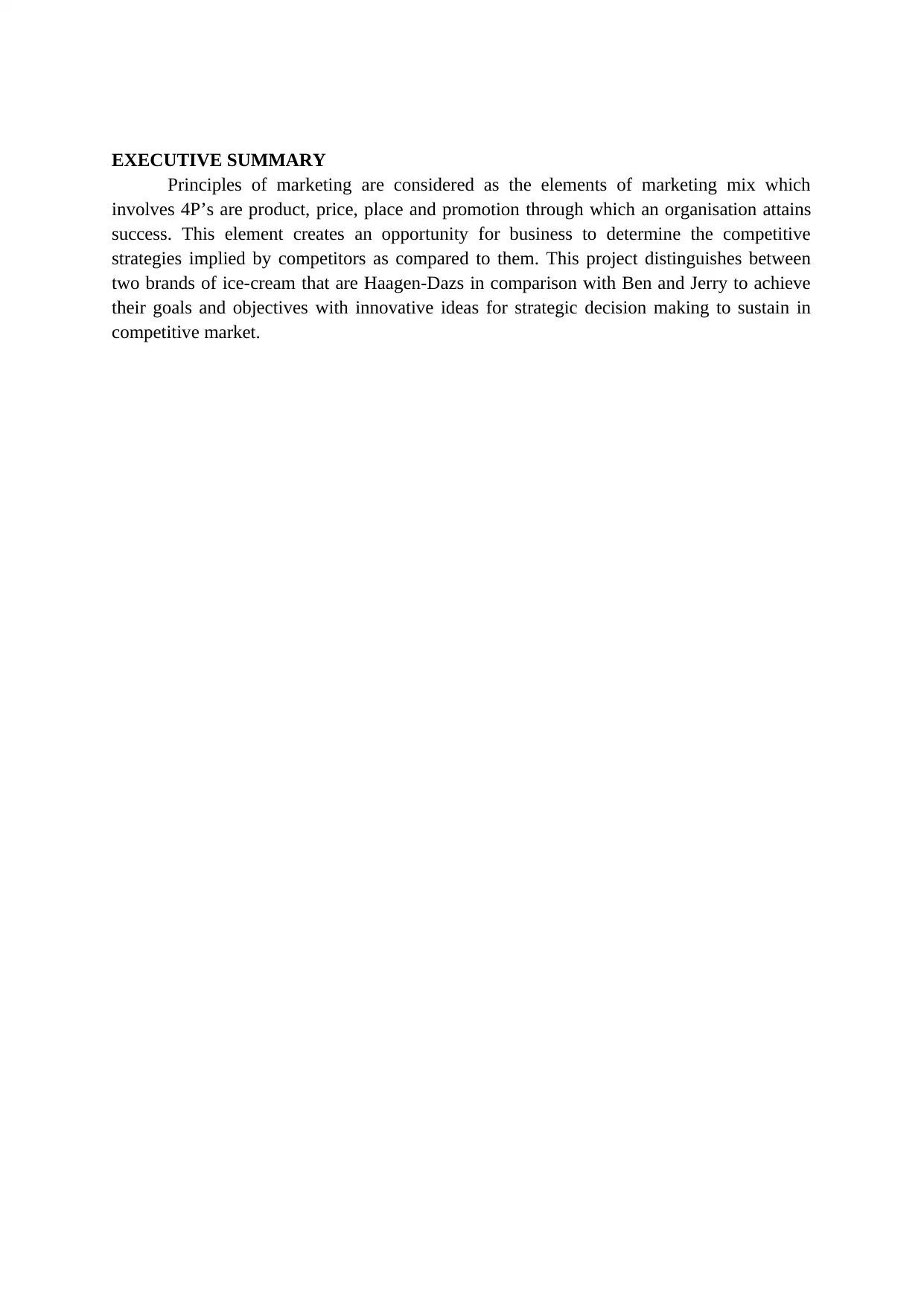
EXECUTIVE SUMMARY
Principles of marketing are considered as the elements of marketing mix which
involves 4P’s are product, price, place and promotion through which an organisation attains
success. This element creates an opportunity for business to determine the competitive
strategies implied by competitors as compared to them. This project distinguishes between
two brands of ice-cream that are Haagen-Dazs in comparison with Ben and Jerry to achieve
their goals and objectives with innovative ideas for strategic decision making to sustain in
competitive market.
Principles of marketing are considered as the elements of marketing mix which
involves 4P’s are product, price, place and promotion through which an organisation attains
success. This element creates an opportunity for business to determine the competitive
strategies implied by competitors as compared to them. This project distinguishes between
two brands of ice-cream that are Haagen-Dazs in comparison with Ben and Jerry to achieve
their goals and objectives with innovative ideas for strategic decision making to sustain in
competitive market.
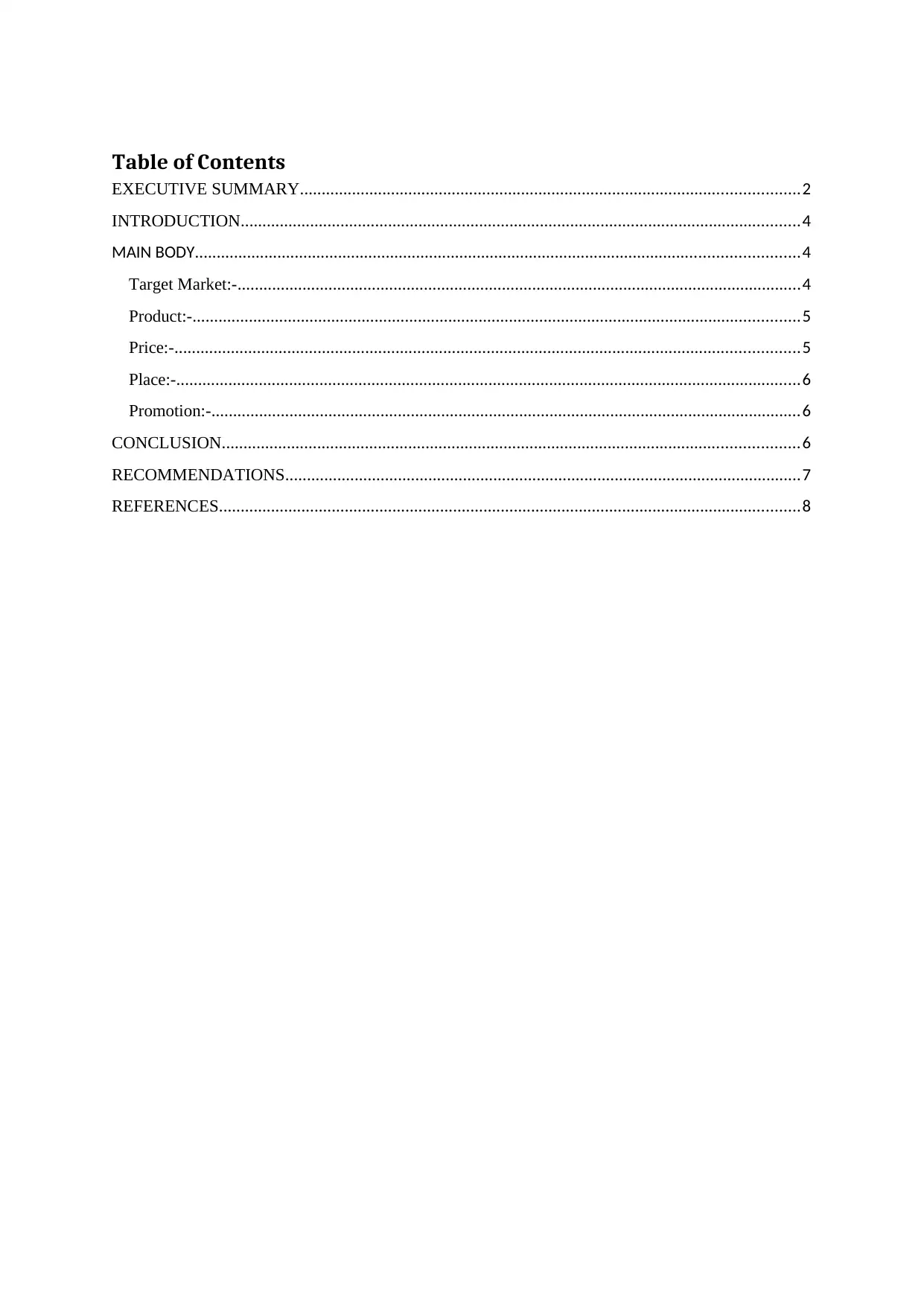
Table of Contents
EXECUTIVE SUMMARY...................................................................................................................2
INTRODUCTION.................................................................................................................................4
MAIN BODY...........................................................................................................................................4
Target Market:-..................................................................................................................................4
Product:-............................................................................................................................................5
Price:-................................................................................................................................................5
Place:-................................................................................................................................................6
Promotion:-........................................................................................................................................6
CONCLUSION.....................................................................................................................................6
RECOMMENDATIONS.......................................................................................................................7
REFERENCES......................................................................................................................................8
EXECUTIVE SUMMARY...................................................................................................................2
INTRODUCTION.................................................................................................................................4
MAIN BODY...........................................................................................................................................4
Target Market:-..................................................................................................................................4
Product:-............................................................................................................................................5
Price:-................................................................................................................................................5
Place:-................................................................................................................................................6
Promotion:-........................................................................................................................................6
CONCLUSION.....................................................................................................................................6
RECOMMENDATIONS.......................................................................................................................7
REFERENCES......................................................................................................................................8
⊘ This is a preview!⊘
Do you want full access?
Subscribe today to unlock all pages.

Trusted by 1+ million students worldwide
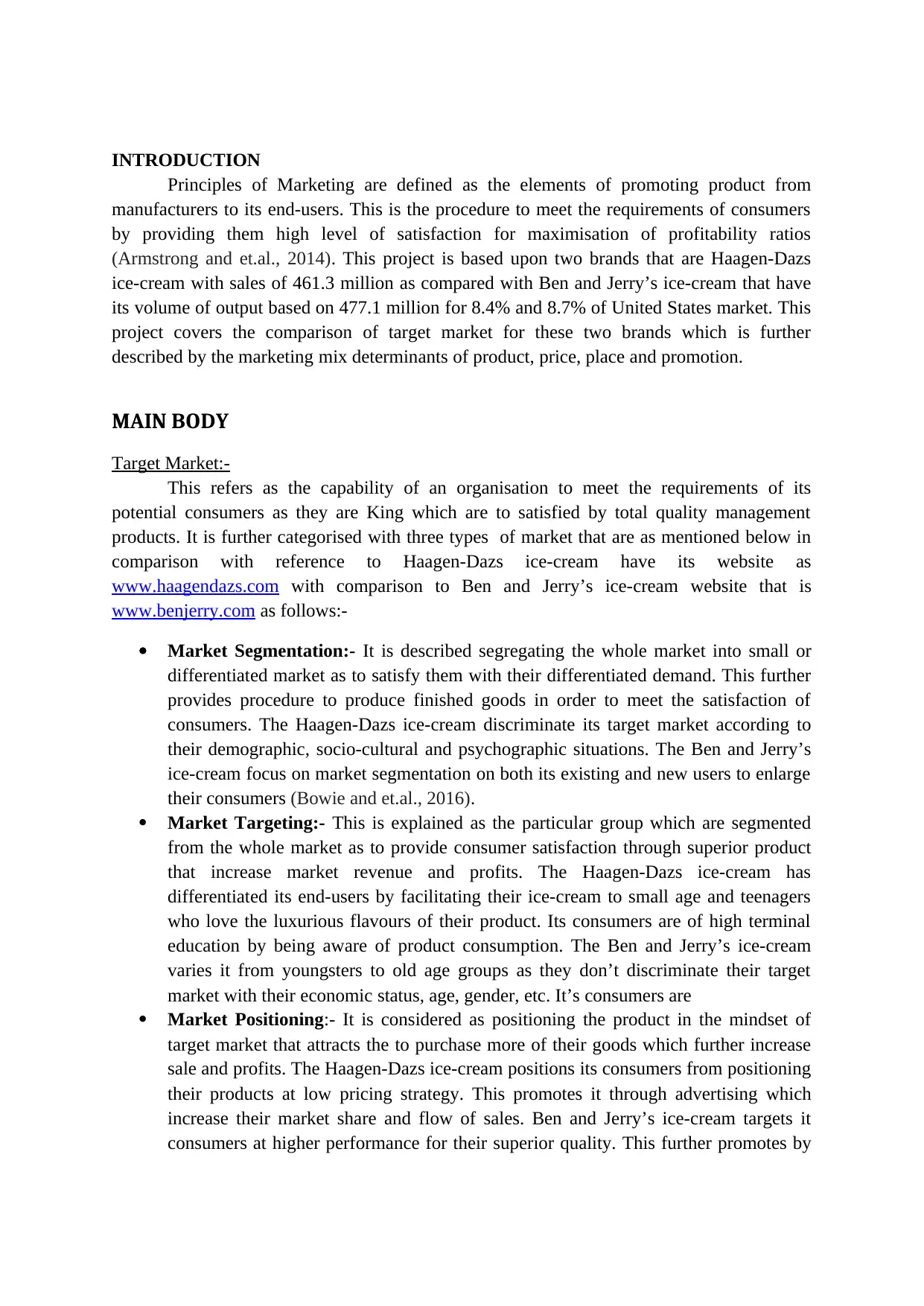
INTRODUCTION
Principles of Marketing are defined as the elements of promoting product from
manufacturers to its end-users. This is the procedure to meet the requirements of consumers
by providing them high level of satisfaction for maximisation of profitability ratios
(Armstrong and et.al., 2014). This project is based upon two brands that are Haagen-Dazs
ice-cream with sales of 461.3 million as compared with Ben and Jerry’s ice-cream that have
its volume of output based on 477.1 million for 8.4% and 8.7% of United States market. This
project covers the comparison of target market for these two brands which is further
described by the marketing mix determinants of product, price, place and promotion.
MAIN BODY
Target Market:-
This refers as the capability of an organisation to meet the requirements of its
potential consumers as they are King which are to satisfied by total quality management
products. It is further categorised with three types of market that are as mentioned below in
comparison with reference to Haagen-Dazs ice-cream have its website as
www.haagendazs.com with comparison to Ben and Jerry’s ice-cream website that is
www.benjerry.com as follows:-
Market Segmentation:- It is described segregating the whole market into small or
differentiated market as to satisfy them with their differentiated demand. This further
provides procedure to produce finished goods in order to meet the satisfaction of
consumers. The Haagen-Dazs ice-cream discriminate its target market according to
their demographic, socio-cultural and psychographic situations. The Ben and Jerry’s
ice-cream focus on market segmentation on both its existing and new users to enlarge
their consumers (Bowie and et.al., 2016).
Market Targeting:- This is explained as the particular group which are segmented
from the whole market as to provide consumer satisfaction through superior product
that increase market revenue and profits. The Haagen-Dazs ice-cream has
differentiated its end-users by facilitating their ice-cream to small age and teenagers
who love the luxurious flavours of their product. Its consumers are of high terminal
education by being aware of product consumption. The Ben and Jerry’s ice-cream
varies it from youngsters to old age groups as they don’t discriminate their target
market with their economic status, age, gender, etc. It’s consumers are
Market Positioning:- It is considered as positioning the product in the mindset of
target market that attracts the to purchase more of their goods which further increase
sale and profits. The Haagen-Dazs ice-cream positions its consumers from positioning
their products at low pricing strategy. This promotes it through advertising which
increase their market share and flow of sales. Ben and Jerry’s ice-cream targets it
consumers at higher performance for their superior quality. This further promotes by
Principles of Marketing are defined as the elements of promoting product from
manufacturers to its end-users. This is the procedure to meet the requirements of consumers
by providing them high level of satisfaction for maximisation of profitability ratios
(Armstrong and et.al., 2014). This project is based upon two brands that are Haagen-Dazs
ice-cream with sales of 461.3 million as compared with Ben and Jerry’s ice-cream that have
its volume of output based on 477.1 million for 8.4% and 8.7% of United States market. This
project covers the comparison of target market for these two brands which is further
described by the marketing mix determinants of product, price, place and promotion.
MAIN BODY
Target Market:-
This refers as the capability of an organisation to meet the requirements of its
potential consumers as they are King which are to satisfied by total quality management
products. It is further categorised with three types of market that are as mentioned below in
comparison with reference to Haagen-Dazs ice-cream have its website as
www.haagendazs.com with comparison to Ben and Jerry’s ice-cream website that is
www.benjerry.com as follows:-
Market Segmentation:- It is described segregating the whole market into small or
differentiated market as to satisfy them with their differentiated demand. This further
provides procedure to produce finished goods in order to meet the satisfaction of
consumers. The Haagen-Dazs ice-cream discriminate its target market according to
their demographic, socio-cultural and psychographic situations. The Ben and Jerry’s
ice-cream focus on market segmentation on both its existing and new users to enlarge
their consumers (Bowie and et.al., 2016).
Market Targeting:- This is explained as the particular group which are segmented
from the whole market as to provide consumer satisfaction through superior product
that increase market revenue and profits. The Haagen-Dazs ice-cream has
differentiated its end-users by facilitating their ice-cream to small age and teenagers
who love the luxurious flavours of their product. Its consumers are of high terminal
education by being aware of product consumption. The Ben and Jerry’s ice-cream
varies it from youngsters to old age groups as they don’t discriminate their target
market with their economic status, age, gender, etc. It’s consumers are
Market Positioning:- It is considered as positioning the product in the mindset of
target market that attracts the to purchase more of their goods which further increase
sale and profits. The Haagen-Dazs ice-cream positions its consumers from positioning
their products at low pricing strategy. This promotes it through advertising which
increase their market share and flow of sales. Ben and Jerry’s ice-cream targets it
consumers at higher performance for their superior quality. This further promotes by
Paraphrase This Document
Need a fresh take? Get an instant paraphrase of this document with our AI Paraphraser
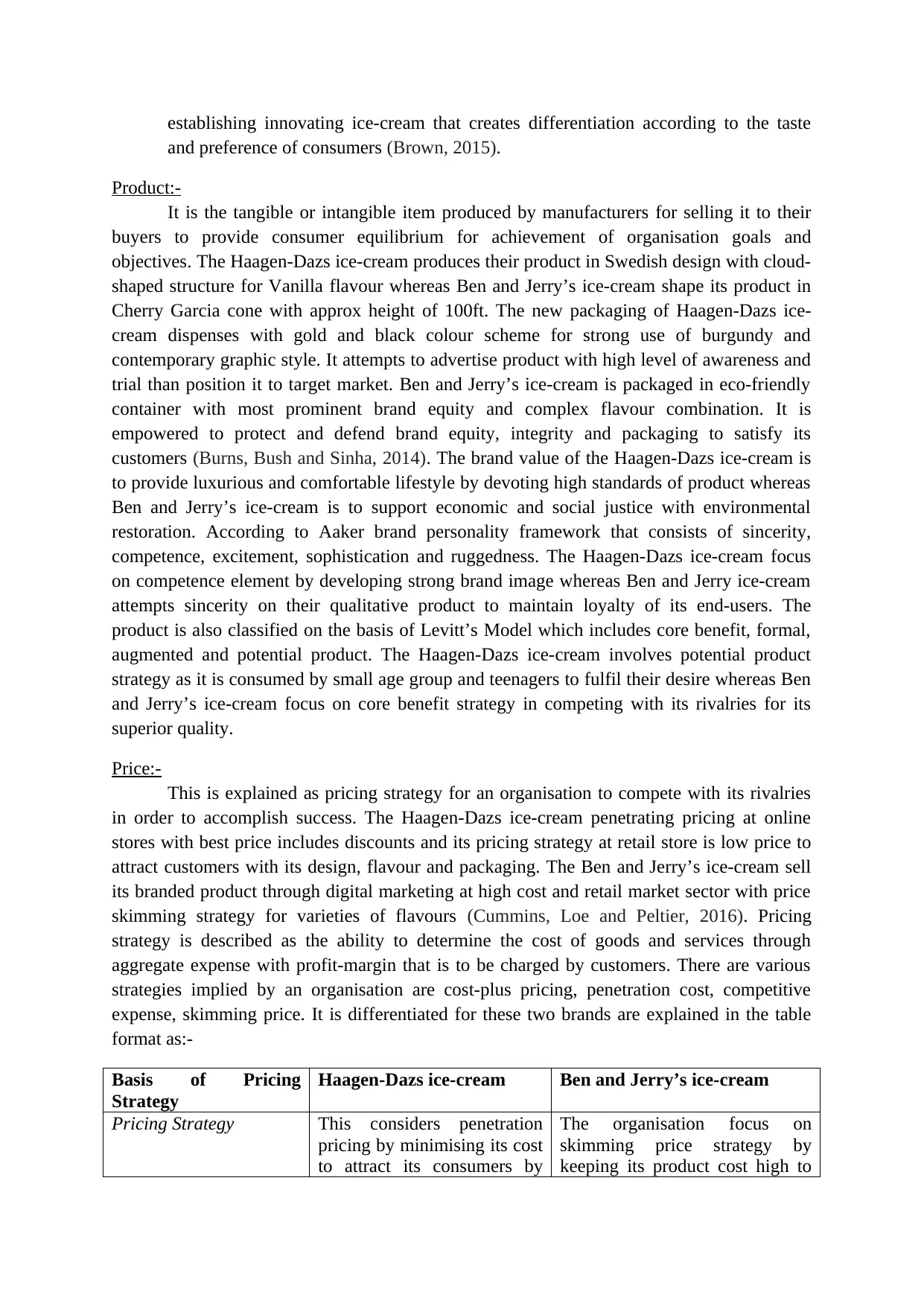
establishing innovating ice-cream that creates differentiation according to the taste
and preference of consumers (Brown, 2015).
Product:-
It is the tangible or intangible item produced by manufacturers for selling it to their
buyers to provide consumer equilibrium for achievement of organisation goals and
objectives. The Haagen-Dazs ice-cream produces their product in Swedish design with cloud-
shaped structure for Vanilla flavour whereas Ben and Jerry’s ice-cream shape its product in
Cherry Garcia cone with approx height of 100ft. The new packaging of Haagen-Dazs ice-
cream dispenses with gold and black colour scheme for strong use of burgundy and
contemporary graphic style. It attempts to advertise product with high level of awareness and
trial than position it to target market. Ben and Jerry’s ice-cream is packaged in eco-friendly
container with most prominent brand equity and complex flavour combination. It is
empowered to protect and defend brand equity, integrity and packaging to satisfy its
customers (Burns, Bush and Sinha, 2014). The brand value of the Haagen-Dazs ice-cream is
to provide luxurious and comfortable lifestyle by devoting high standards of product whereas
Ben and Jerry’s ice-cream is to support economic and social justice with environmental
restoration. According to Aaker brand personality framework that consists of sincerity,
competence, excitement, sophistication and ruggedness. The Haagen-Dazs ice-cream focus
on competence element by developing strong brand image whereas Ben and Jerry ice-cream
attempts sincerity on their qualitative product to maintain loyalty of its end-users. The
product is also classified on the basis of Levitt’s Model which includes core benefit, formal,
augmented and potential product. The Haagen-Dazs ice-cream involves potential product
strategy as it is consumed by small age group and teenagers to fulfil their desire whereas Ben
and Jerry’s ice-cream focus on core benefit strategy in competing with its rivalries for its
superior quality.
Price:-
This is explained as pricing strategy for an organisation to compete with its rivalries
in order to accomplish success. The Haagen-Dazs ice-cream penetrating pricing at online
stores with best price includes discounts and its pricing strategy at retail store is low price to
attract customers with its design, flavour and packaging. The Ben and Jerry’s ice-cream sell
its branded product through digital marketing at high cost and retail market sector with price
skimming strategy for varieties of flavours (Cummins, Loe and Peltier, 2016). Pricing
strategy is described as the ability to determine the cost of goods and services through
aggregate expense with profit-margin that is to be charged by customers. There are various
strategies implied by an organisation are cost-plus pricing, penetration cost, competitive
expense, skimming price. It is differentiated for these two brands are explained in the table
format as:-
Basis of Pricing
Strategy
Haagen-Dazs ice-cream Ben and Jerry’s ice-cream
Pricing Strategy This considers penetration
pricing by minimising its cost
to attract its consumers by
The organisation focus on
skimming price strategy by
keeping its product cost high to
and preference of consumers (Brown, 2015).
Product:-
It is the tangible or intangible item produced by manufacturers for selling it to their
buyers to provide consumer equilibrium for achievement of organisation goals and
objectives. The Haagen-Dazs ice-cream produces their product in Swedish design with cloud-
shaped structure for Vanilla flavour whereas Ben and Jerry’s ice-cream shape its product in
Cherry Garcia cone with approx height of 100ft. The new packaging of Haagen-Dazs ice-
cream dispenses with gold and black colour scheme for strong use of burgundy and
contemporary graphic style. It attempts to advertise product with high level of awareness and
trial than position it to target market. Ben and Jerry’s ice-cream is packaged in eco-friendly
container with most prominent brand equity and complex flavour combination. It is
empowered to protect and defend brand equity, integrity and packaging to satisfy its
customers (Burns, Bush and Sinha, 2014). The brand value of the Haagen-Dazs ice-cream is
to provide luxurious and comfortable lifestyle by devoting high standards of product whereas
Ben and Jerry’s ice-cream is to support economic and social justice with environmental
restoration. According to Aaker brand personality framework that consists of sincerity,
competence, excitement, sophistication and ruggedness. The Haagen-Dazs ice-cream focus
on competence element by developing strong brand image whereas Ben and Jerry ice-cream
attempts sincerity on their qualitative product to maintain loyalty of its end-users. The
product is also classified on the basis of Levitt’s Model which includes core benefit, formal,
augmented and potential product. The Haagen-Dazs ice-cream involves potential product
strategy as it is consumed by small age group and teenagers to fulfil their desire whereas Ben
and Jerry’s ice-cream focus on core benefit strategy in competing with its rivalries for its
superior quality.
Price:-
This is explained as pricing strategy for an organisation to compete with its rivalries
in order to accomplish success. The Haagen-Dazs ice-cream penetrating pricing at online
stores with best price includes discounts and its pricing strategy at retail store is low price to
attract customers with its design, flavour and packaging. The Ben and Jerry’s ice-cream sell
its branded product through digital marketing at high cost and retail market sector with price
skimming strategy for varieties of flavours (Cummins, Loe and Peltier, 2016). Pricing
strategy is described as the ability to determine the cost of goods and services through
aggregate expense with profit-margin that is to be charged by customers. There are various
strategies implied by an organisation are cost-plus pricing, penetration cost, competitive
expense, skimming price. It is differentiated for these two brands are explained in the table
format as:-
Basis of Pricing
Strategy
Haagen-Dazs ice-cream Ben and Jerry’s ice-cream
Pricing Strategy This considers penetration
pricing by minimising its cost
to attract its consumers by
The organisation focus on
skimming price strategy by
keeping its product cost high to
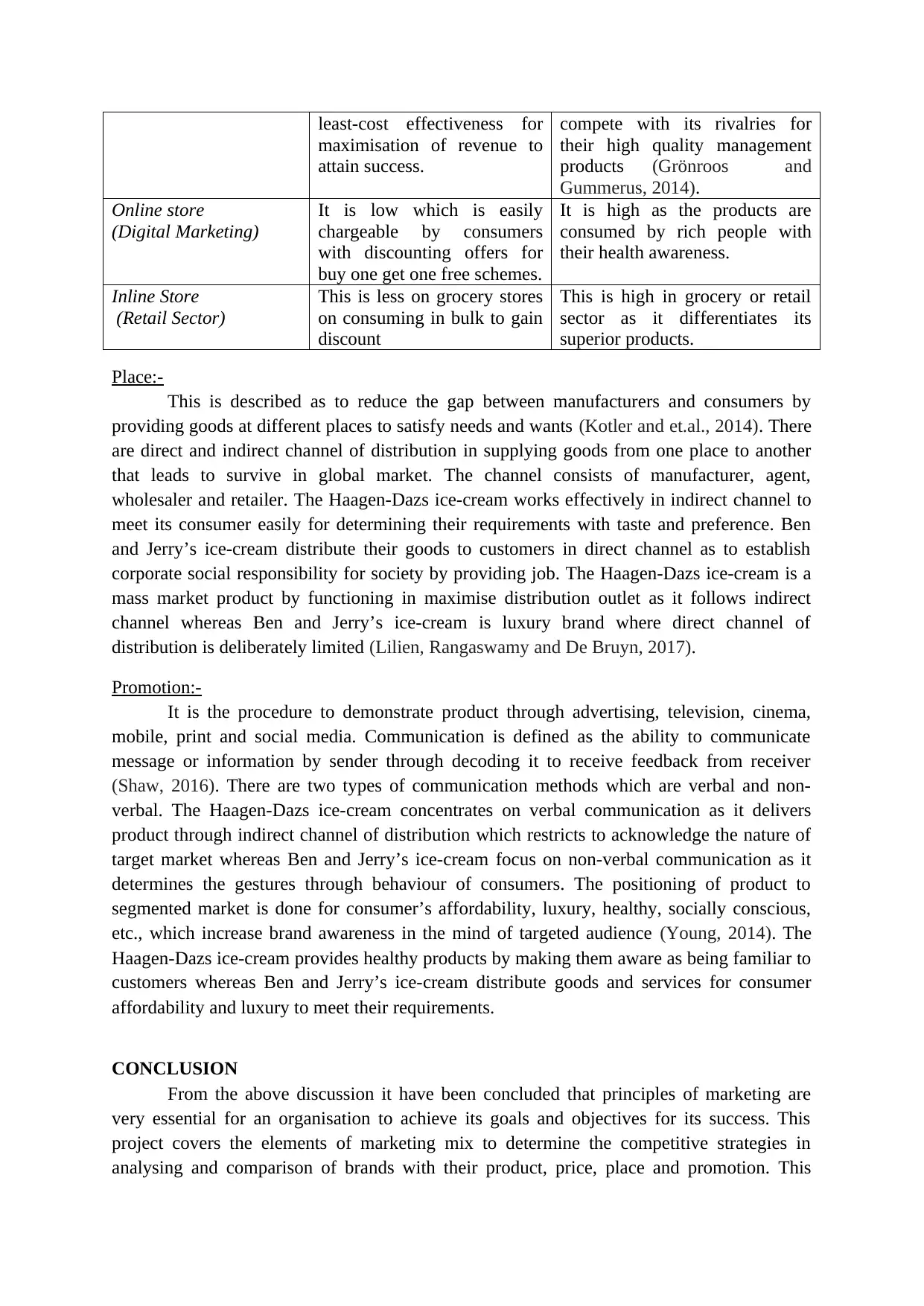
least-cost effectiveness for
maximisation of revenue to
attain success.
compete with its rivalries for
their high quality management
products (Grönroos and
Gummerus, 2014).
Online store
(Digital Marketing)
It is low which is easily
chargeable by consumers
with discounting offers for
buy one get one free schemes.
It is high as the products are
consumed by rich people with
their health awareness.
Inline Store
(Retail Sector)
This is less on grocery stores
on consuming in bulk to gain
discount
This is high in grocery or retail
sector as it differentiates its
superior products.
Place:-
This is described as to reduce the gap between manufacturers and consumers by
providing goods at different places to satisfy needs and wants (Kotler and et.al., 2014). There
are direct and indirect channel of distribution in supplying goods from one place to another
that leads to survive in global market. The channel consists of manufacturer, agent,
wholesaler and retailer. The Haagen-Dazs ice-cream works effectively in indirect channel to
meet its consumer easily for determining their requirements with taste and preference. Ben
and Jerry’s ice-cream distribute their goods to customers in direct channel as to establish
corporate social responsibility for society by providing job. The Haagen-Dazs ice-cream is a
mass market product by functioning in maximise distribution outlet as it follows indirect
channel whereas Ben and Jerry’s ice-cream is luxury brand where direct channel of
distribution is deliberately limited (Lilien, Rangaswamy and De Bruyn, 2017).
Promotion:-
It is the procedure to demonstrate product through advertising, television, cinema,
mobile, print and social media. Communication is defined as the ability to communicate
message or information by sender through decoding it to receive feedback from receiver
(Shaw, 2016). There are two types of communication methods which are verbal and non-
verbal. The Haagen-Dazs ice-cream concentrates on verbal communication as it delivers
product through indirect channel of distribution which restricts to acknowledge the nature of
target market whereas Ben and Jerry’s ice-cream focus on non-verbal communication as it
determines the gestures through behaviour of consumers. The positioning of product to
segmented market is done for consumer’s affordability, luxury, healthy, socially conscious,
etc., which increase brand awareness in the mind of targeted audience (Young, 2014). The
Haagen-Dazs ice-cream provides healthy products by making them aware as being familiar to
customers whereas Ben and Jerry’s ice-cream distribute goods and services for consumer
affordability and luxury to meet their requirements.
CONCLUSION
From the above discussion it have been concluded that principles of marketing are
very essential for an organisation to achieve its goals and objectives for its success. This
project covers the elements of marketing mix to determine the competitive strategies in
analysing and comparison of brands with their product, price, place and promotion. This
maximisation of revenue to
attain success.
compete with its rivalries for
their high quality management
products (Grönroos and
Gummerus, 2014).
Online store
(Digital Marketing)
It is low which is easily
chargeable by consumers
with discounting offers for
buy one get one free schemes.
It is high as the products are
consumed by rich people with
their health awareness.
Inline Store
(Retail Sector)
This is less on grocery stores
on consuming in bulk to gain
discount
This is high in grocery or retail
sector as it differentiates its
superior products.
Place:-
This is described as to reduce the gap between manufacturers and consumers by
providing goods at different places to satisfy needs and wants (Kotler and et.al., 2014). There
are direct and indirect channel of distribution in supplying goods from one place to another
that leads to survive in global market. The channel consists of manufacturer, agent,
wholesaler and retailer. The Haagen-Dazs ice-cream works effectively in indirect channel to
meet its consumer easily for determining their requirements with taste and preference. Ben
and Jerry’s ice-cream distribute their goods to customers in direct channel as to establish
corporate social responsibility for society by providing job. The Haagen-Dazs ice-cream is a
mass market product by functioning in maximise distribution outlet as it follows indirect
channel whereas Ben and Jerry’s ice-cream is luxury brand where direct channel of
distribution is deliberately limited (Lilien, Rangaswamy and De Bruyn, 2017).
Promotion:-
It is the procedure to demonstrate product through advertising, television, cinema,
mobile, print and social media. Communication is defined as the ability to communicate
message or information by sender through decoding it to receive feedback from receiver
(Shaw, 2016). There are two types of communication methods which are verbal and non-
verbal. The Haagen-Dazs ice-cream concentrates on verbal communication as it delivers
product through indirect channel of distribution which restricts to acknowledge the nature of
target market whereas Ben and Jerry’s ice-cream focus on non-verbal communication as it
determines the gestures through behaviour of consumers. The positioning of product to
segmented market is done for consumer’s affordability, luxury, healthy, socially conscious,
etc., which increase brand awareness in the mind of targeted audience (Young, 2014). The
Haagen-Dazs ice-cream provides healthy products by making them aware as being familiar to
customers whereas Ben and Jerry’s ice-cream distribute goods and services for consumer
affordability and luxury to meet their requirements.
CONCLUSION
From the above discussion it have been concluded that principles of marketing are
very essential for an organisation to achieve its goals and objectives for its success. This
project covers the elements of marketing mix to determine the competitive strategies in
analysing and comparison of brands with their product, price, place and promotion. This
⊘ This is a preview!⊘
Do you want full access?
Subscribe today to unlock all pages.

Trusted by 1+ million students worldwide
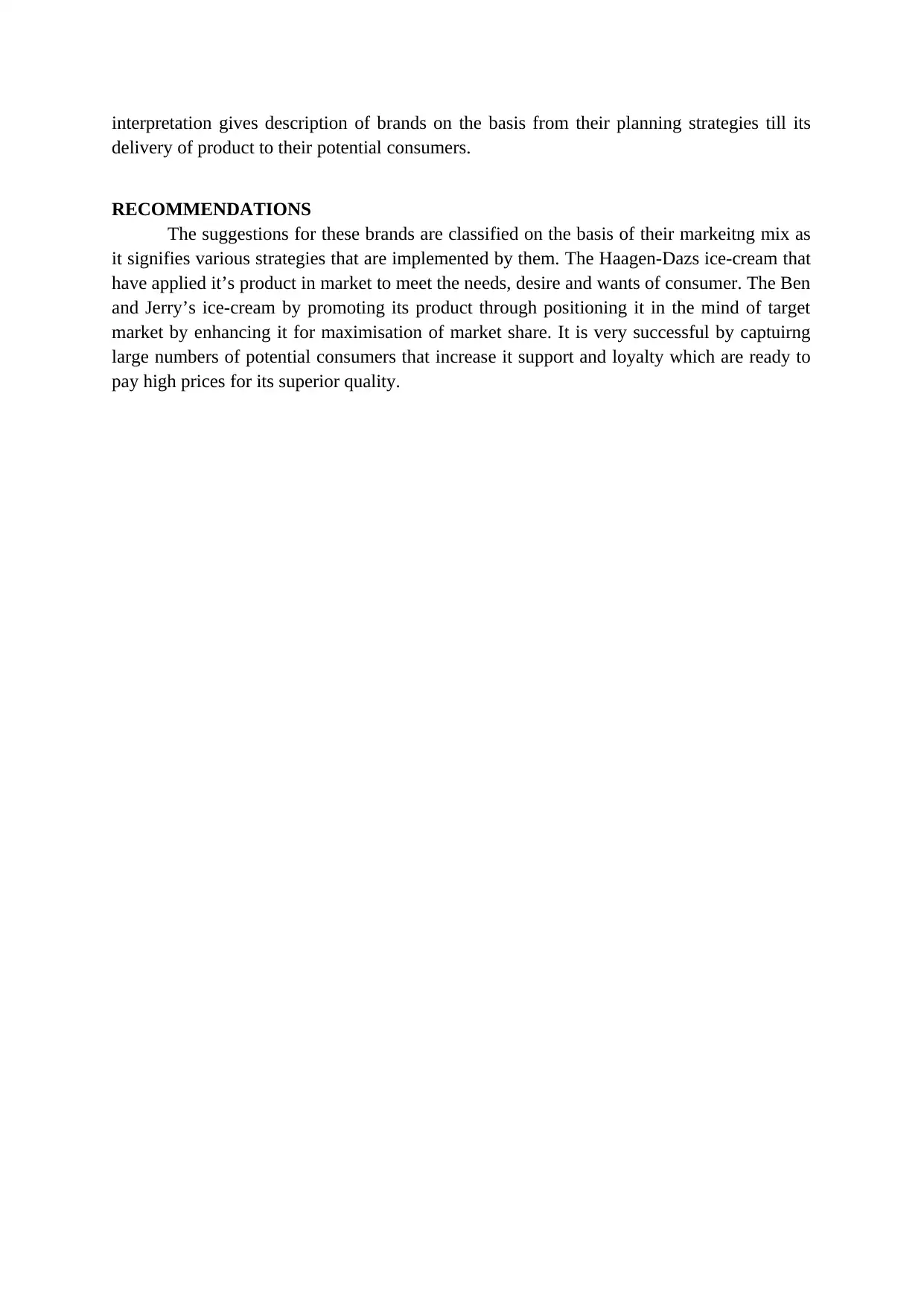
interpretation gives description of brands on the basis from their planning strategies till its
delivery of product to their potential consumers.
RECOMMENDATIONS
The suggestions for these brands are classified on the basis of their markeitng mix as
it signifies various strategies that are implemented by them. The Haagen-Dazs ice-cream that
have applied it’s product in market to meet the needs, desire and wants of consumer. The Ben
and Jerry’s ice-cream by promoting its product through positioning it in the mind of target
market by enhancing it for maximisation of market share. It is very successful by captuirng
large numbers of potential consumers that increase it support and loyalty which are ready to
pay high prices for its superior quality.
delivery of product to their potential consumers.
RECOMMENDATIONS
The suggestions for these brands are classified on the basis of their markeitng mix as
it signifies various strategies that are implemented by them. The Haagen-Dazs ice-cream that
have applied it’s product in market to meet the needs, desire and wants of consumer. The Ben
and Jerry’s ice-cream by promoting its product through positioning it in the mind of target
market by enhancing it for maximisation of market share. It is very successful by captuirng
large numbers of potential consumers that increase it support and loyalty which are ready to
pay high prices for its superior quality.
Paraphrase This Document
Need a fresh take? Get an instant paraphrase of this document with our AI Paraphraser
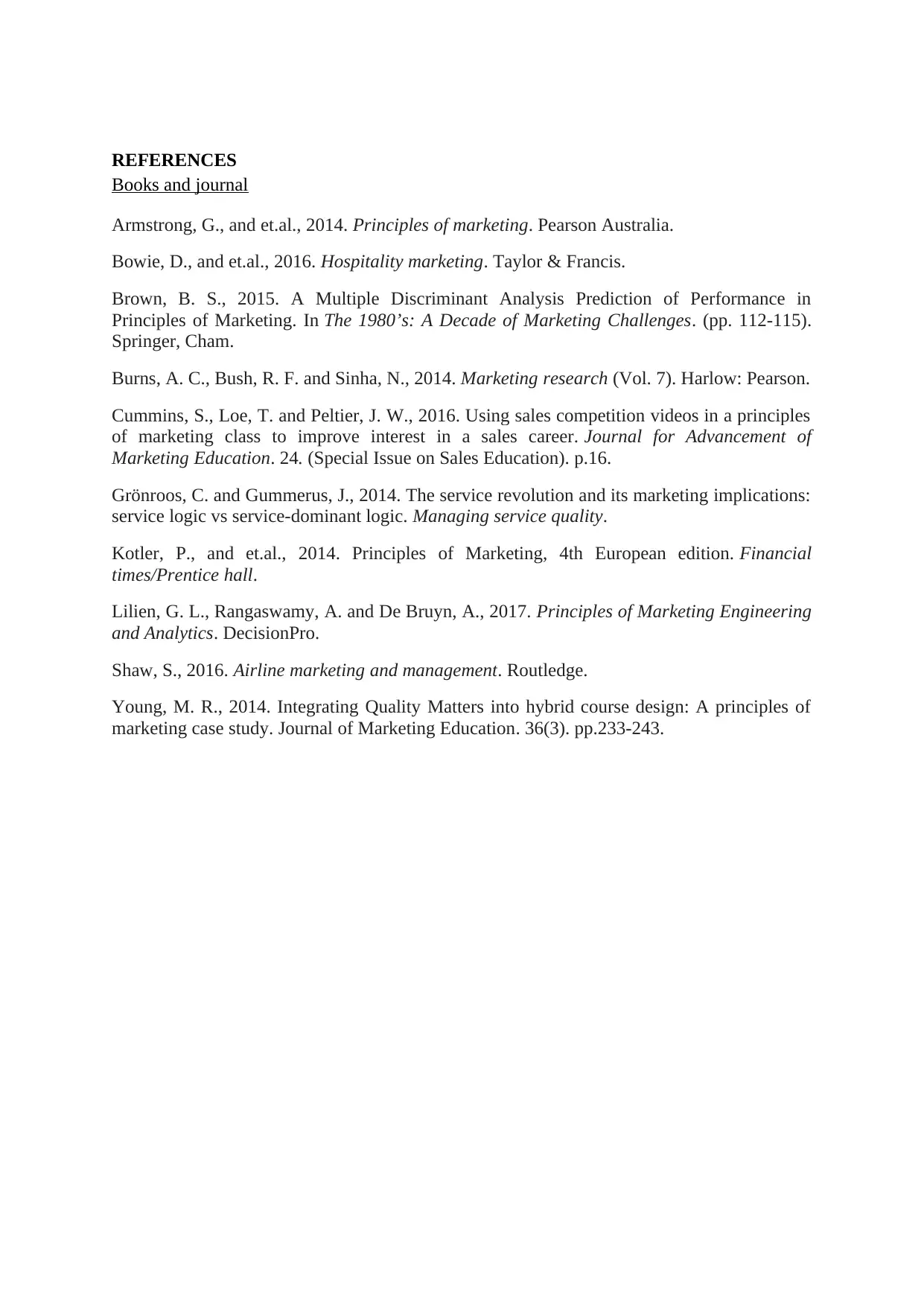
REFERENCES
Books and journal
Armstrong, G., and et.al., 2014. Principles of marketing. Pearson Australia.
Bowie, D., and et.al., 2016. Hospitality marketing. Taylor & Francis.
Brown, B. S., 2015. A Multiple Discriminant Analysis Prediction of Performance in
Principles of Marketing. In The 1980’s: A Decade of Marketing Challenges. (pp. 112-115).
Springer, Cham.
Burns, A. C., Bush, R. F. and Sinha, N., 2014. Marketing research (Vol. 7). Harlow: Pearson.
Cummins, S., Loe, T. and Peltier, J. W., 2016. Using sales competition videos in a principles
of marketing class to improve interest in a sales career. Journal for Advancement of
Marketing Education. 24. (Special Issue on Sales Education). p.16.
Grönroos, C. and Gummerus, J., 2014. The service revolution and its marketing implications:
service logic vs service-dominant logic. Managing service quality.
Kotler, P., and et.al., 2014. Principles of Marketing, 4th European edition. Financial
times/Prentice hall.
Lilien, G. L., Rangaswamy, A. and De Bruyn, A., 2017. Principles of Marketing Engineering
and Analytics. DecisionPro.
Shaw, S., 2016. Airline marketing and management. Routledge.
Young, M. R., 2014. Integrating Quality Matters into hybrid course design: A principles of
marketing case study. Journal of Marketing Education. 36(3). pp.233-243.
Books and journal
Armstrong, G., and et.al., 2014. Principles of marketing. Pearson Australia.
Bowie, D., and et.al., 2016. Hospitality marketing. Taylor & Francis.
Brown, B. S., 2015. A Multiple Discriminant Analysis Prediction of Performance in
Principles of Marketing. In The 1980’s: A Decade of Marketing Challenges. (pp. 112-115).
Springer, Cham.
Burns, A. C., Bush, R. F. and Sinha, N., 2014. Marketing research (Vol. 7). Harlow: Pearson.
Cummins, S., Loe, T. and Peltier, J. W., 2016. Using sales competition videos in a principles
of marketing class to improve interest in a sales career. Journal for Advancement of
Marketing Education. 24. (Special Issue on Sales Education). p.16.
Grönroos, C. and Gummerus, J., 2014. The service revolution and its marketing implications:
service logic vs service-dominant logic. Managing service quality.
Kotler, P., and et.al., 2014. Principles of Marketing, 4th European edition. Financial
times/Prentice hall.
Lilien, G. L., Rangaswamy, A. and De Bruyn, A., 2017. Principles of Marketing Engineering
and Analytics. DecisionPro.
Shaw, S., 2016. Airline marketing and management. Routledge.
Young, M. R., 2014. Integrating Quality Matters into hybrid course design: A principles of
marketing case study. Journal of Marketing Education. 36(3). pp.233-243.
1 out of 8
Related Documents
Your All-in-One AI-Powered Toolkit for Academic Success.
+13062052269
info@desklib.com
Available 24*7 on WhatsApp / Email
![[object Object]](/_next/static/media/star-bottom.7253800d.svg)
Unlock your academic potential
Copyright © 2020–2025 A2Z Services. All Rights Reserved. Developed and managed by ZUCOL.





